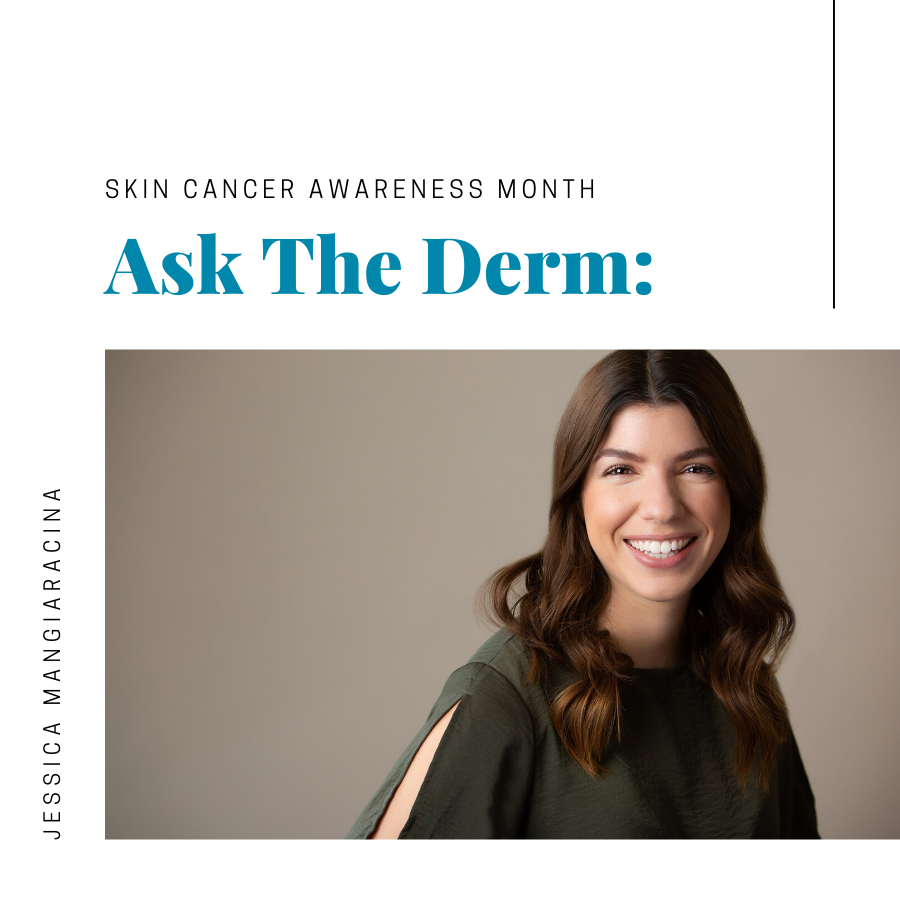
Ask The Derm: Jessica Mangiaracina
We are so excited to share with you our first skin professional feature during Skin Cancer Awareness Month! Jessica Mangiaracina is a board certified Physician Assistant specializing in dermatology since 2014. ⠀⠀
Jessica is our guest blogger this week! She will go into detail about what exactly skin cancer is, facts, statistics, and ways that you can protect your skin and minimize your risk of developing skin cancer. She details the ABCDEs of Melanoma and gives warning signs to look out for. Keep reading for Jessica's Information and Suggestions.
Jaw dropping facts:
- Skin cancer is the most common cancer in the United States and worldwide.
- 1 in 5 Americans will develop skin cancer by the age of 70.
- More than 2 people die of skin cancer in the U.S. every hour.
- Having 5 or more sunburns doubles your risk for melanoma.
- Men age 49 and under have a higher probability of developing melanoma than any other cancer.
- Regular daily use of an SPF 15 or higher sunscreen reduces the risk of developing melanoma by 50 percent.
- Only 20 to 30 percent of melanomas are found in existing moles, while 70 to 80 percent arise on apparently normal skin.
There are certain risk factors in developing skin cancer:
- Indoor tanning - 75% increased risk of developing life-threatening melanoma from just one indoor tanning session before age 35.
- Sunburns- your risk of developing potentially deadly melanoma doubles with a history of 5 or more sunburns.
- Skin type - Fair skin / easily burned skin at an increased risk, however people of any ethnic background, even those who always tan or rarely burn, can still get skin cancer.
- Unprotected sun exposure to UVA/ UVB rays
- Genetics
- Atypical moles - these are unusual-looking moles that have irregular features under the microscope. Though benign, they are worth more of your attention because individuals with atypical moles are at increased risk for melanoma. People with 10 or more atypical moles have 12 time the risk of melanoma.
- Organ transplant
- Red hair
The ABCDE of melanoma:

A is for Asymmetry. Most melanomas are asymmetrical. If you draw a line through the middle of the lesion, the two halves don’t match, so it looks different from a round to oval and symmetrical common mole.
B is for Border. Melanoma borders tend to be uneven and may have scalloped or notched edges, while common moles tend to have smoother, more even borders.
C is for Color. Multiple colors are a warning sign. While benign moles are usually a single shade of brown, a melanoma may have different shades of brown, tan or black. As it grows, the colors red, white or blue may also appear.
D is for Diameter or Dark. While it’s ideal to detect a melanoma when it is small, it’s a warning sign if a lesion is the size of a pencil eraser (about 6 mm, or ¼ inch in diameter) or larger. Some experts say it is also important to look for any lesion, no matter what size, that is darker than others. Rare, amelanotic melanomas are colorless.
E is for Evolving. Any change in size, shape, color or elevation of a spot on your skin, or any new symptom in it, such as bleeding, itching or crusting, may be a warning sign of melanoma.
There are certain warning signs that people should look for on their skin to detect skin cancer:
- Look for anything new, changing or unusual on both sun-exposed and sun-protected areas of the body.
- Look for the Ugly duckling sign: most normal moles on your body resemble one another, while melanomas stand out like ugly ducklings in comparison. Also, isolated lesions without any surrounding moles for comparison are considered ugly ducklings.
- Look at your nails - melanoma can appear in finger and toe nails. It starts as a brown or black streak under a fingernail or a toenail, but often increases in size.

- Rough, dry skin that does not go away with lip balm is a sign of sun damage. Squamous cell carcinoma can appear here.
- Look for a raised warty like horn on your skin, this could be a sign of a pre-skin cancer or squamous cell carcinoma.

- Be watchful for any new mole or freckle that arises on your skin, a sore or spot that does not heal, a change in any existing mole (growing, swelling, itching) or any spot, mole or lesion that looks unusual.
Here are some ways to protect your skin from the sun:
1. Sunscreen is key to protecting your skin.
2. Clothing can provide a great barrier against the sun’s ultraviolet (UV) rays. Its protection is consistent over time and doesn’t wear off like sunscreen does. Look for UPF, which stands for ultraviolet protection factor, on labels for clothing, hats and fabrics.
3. Seek the shade during the peak hours of sun: 10 AM to 4 PM.
4. A healthy diet can also protect your skin from developing skin cancer. Eat foods that contain antioxidants such as Vitamins C, E and A, zinc, selenium, beta carotene (carotenoids), omega-3 fatty acids, lycopene and polyphenols.
5. Another supplement called Polypodium leucotomos is an antioxidant, which comes from a fern, is the key ingredient in several products. Studies have shown that it helps prevent both UVA- and UVB-induced toxicity and DNA damage and reduces free radicals, those potentially cancer-causing oxygen molecules caused by UV exposure. A recent study showed that 240 mg of the supplement twice daily suppressed sunburn, and it has been found to extend the time outdoors before your skin starts to tan.
6. Performing self skin exams at home are important to help detect skin cancers early. It is recommended to check your skin once a month. Skin checks by a dermatology provider are recommended yearly, sometimes every 6 months if you have a lot of moles.



Leave a comment
This site is protected by reCAPTCHA and the Google Privacy Policy and Terms of Service apply.